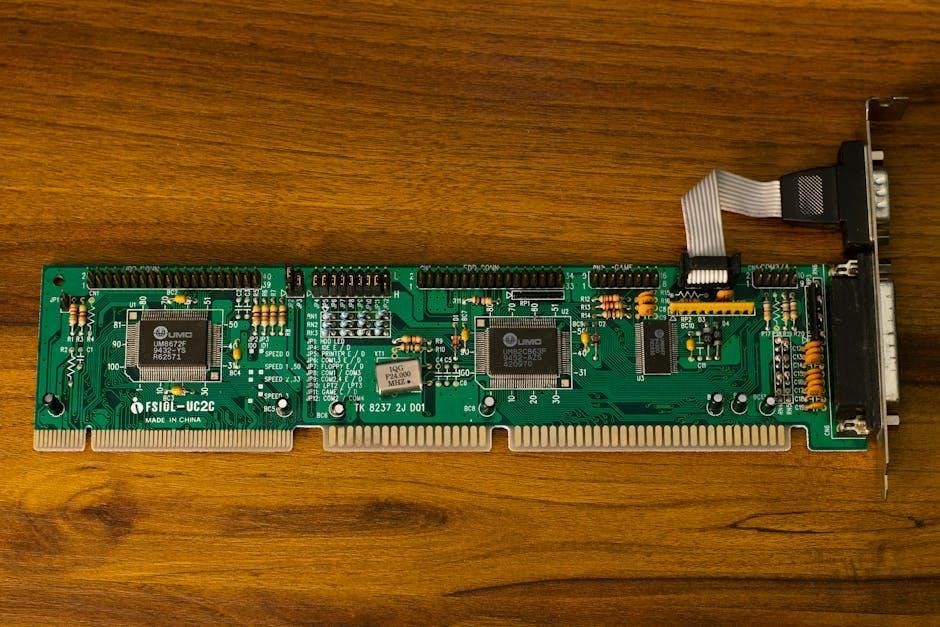Understanding the 2005 Chevy Silverado’s electrical system requires a detailed wiring diagram PDF; resources include online databases and official Chevrolet documentation.
Accessing these schematics unlocks installation‚ operation‚ and maintenance insights‚ vital for troubleshooting and repair of systems like AC and ABS.
Detailed diagrams showcase wiring for 1500 and 2500HD models‚ alongside specifics for radio‚ power windows‚ and the engine control module (ECM).

Overview of the Electrical System
The 2005 Chevy Silverado’s electrical architecture is a complex network powering numerous functions‚ from essential systems like starting and charging to convenience features like power windows and the radio. A comprehensive wiring diagram PDF is crucial for navigating this intricacy.
Key components include the Body Control Module (BCM)‚ managing body functions‚ and the Engine Control Module (ECM)‚ controlling engine performance. Power and ground distribution are fundamental‚ with various wire colors denoting specific circuits. Understanding these circuits‚ detailed in available schematics‚ is paramount.
Systems like anti-lock brakes (ABS) and air conditioning also have dedicated wiring‚ often found within specialized diagrams. Proper diagnosis and repair necessitate a clear grasp of this interconnectedness‚ readily available through a detailed 2005 Silverado wiring diagram PDF.
Importance of a Wiring Diagram
A 2005 Chevy Silverado wiring diagram PDF is indispensable for any electrical work‚ acting as a roadmap to the vehicle’s intricate system. Without it‚ troubleshooting becomes guesswork‚ potentially leading to further damage and costly repairs. Accurate schematics pinpoint wire locations‚ colors‚ and connections‚ crucial for diagnosing shorts‚ opens‚ and component failures.
Effective repairs rely on understanding the flow of electricity‚ which a diagram clearly illustrates. Modifications‚ like trailer harness integration or audio system upgrades‚ demand precise wiring knowledge. Accessing these diagrams—whether from official Chevrolet sources or reputable third-party providers—ensures safe and efficient work.

Locating a 2005 Chevy Silverado Wiring Diagram PDF
Finding a 2005 Chevy Silverado wiring diagram PDF involves exploring online resources‚ official Chevrolet documentation‚ and reliable third-party providers for schematics;
Online Resources for Diagrams
Numerous online platforms offer access to 2005 Chevy Silverado wiring diagram PDFs‚ though reliability varies. Forums dedicated to Chevrolet vehicles frequently host shared diagrams‚ often uploaded by members experiencing similar repair needs. Websites specializing in automotive repair manuals often require a subscription or one-time payment to download the specific wiring diagrams you require.
Be cautious when downloading from unfamiliar sources‚ ensuring the file is virus-free. Some sites may offer incomplete or inaccurate schematics. Mitchell Repair Information Company‚ LLC‚ is mentioned as a source within some documents‚ suggesting their database may be helpful. Always cross-reference information when possible to confirm accuracy.
Official Chevrolet Documentation
Obtaining official 2005 Chevy Silverado wiring diagrams directly from Chevrolet provides the most accurate and reliable information. However‚ accessing this documentation can be challenging and often involves a cost. Chevrolet dealerships may offer to print specific schematics for a fee‚ or provide access to their service information system.
GM’s official service manuals‚ available through some authorized retailers‚ contain comprehensive wiring diagrams. These manuals are typically sold as complete sets covering all aspects of vehicle repair. While expensive‚ they represent the gold standard for accuracy and detail‚ ensuring correct diagnosis and repair procedures.
Third-Party Wiring Diagram Providers
Numerous third-party providers offer 2005 Chevy Silverado wiring diagrams as a more accessible alternative to official Chevrolet documentation. Companies like Mitchell OnDemand5 and ALLDATA provide subscription-based access to extensive databases of vehicle repair information‚ including detailed wiring schematics in PDF format.
These services often feature user-friendly interfaces and search capabilities‚ allowing technicians to quickly locate the specific diagram needed. While generally less expensive than official manuals‚ verifying the accuracy and completeness of the information is crucial before relying on it for repairs;
Understanding the Wiring Diagram Symbols
Decoding the 2005 Chevy Silverado wiring diagram requires familiarity with standard symbols‚ wire colors (like brown for parking lights)‚ and notations for components.
Common Wire Colors and Their Functions
Identifying wire colors is crucial when using a 2005 Chevy Silverado wiring diagram PDF. Black wires typically serve as ground connections‚ while white or gray often indicate sensor signals.
Brown wires frequently represent parking lamp power‚ and red wires commonly carry battery or ignition voltage.
Black/White or Black/Red wires can be found in door harnesses‚ relating to parking lights and door triggers.

Understanding these conventions‚ alongside specific diagram notations‚ allows for accurate tracing of circuits and component identification during electrical troubleshooting and repair.
Identifying Electrical Components
A 2005 Chevy Silverado wiring diagram PDF details numerous electrical components. These include the Body Control Module (BCM)‚ Engine Control Module (ECM)‚ anti-lock braking system (ABS) modules‚ and various sensors.
Diagrams illustrate the location and pinouts of connectors for headlights‚ tail lights‚ and turn signals.
Furthermore‚ schematics pinpoint the power and ground distribution points throughout the vehicle.
Accurate identification of these components‚ coupled with understanding their corresponding symbols on the diagram‚ is essential for effective diagnosis and repair of electrical issues.
Decoding Diagram Notations
A 2005 Chevy Silverado wiring diagram PDF employs specific notations for clarity. Voltage readings‚ wire gauge sizes‚ and connector views are commonly included.
Abbreviations denote component functions – for example‚ “PARKING LIGHTS” or “DOOR TRIGGER WIRE.”
Color codes‚ like “BRN” for brown wires‚ indicate circuit functions.
Understanding these notations is crucial; a diagram might show “Voltage at Headlight Switch” or specify a wire’s destination.
Mastering these symbols and abbreviations allows technicians to accurately trace circuits and diagnose electrical faults efficiently.
Key Electrical Systems and Their Diagrams
A 2005 Chevy Silverado wiring diagram PDF details power distribution‚ starting‚ charging‚ lighting‚ and the Body Control Module (BCM) systems.

These diagrams are essential for tracing circuits and diagnosing electrical issues within these core vehicle functions.
Power and Ground Distribution
The 2005 Chevy Silverado wiring diagram PDF meticulously illustrates the vehicle’s power and ground distribution network. Diagrams reveal the main power sources‚ including the battery and alternator‚ and how electricity is routed through the fuse boxes to various components.
Crucially‚ these schematics pinpoint common ground points – essential for proper electrical function – located throughout the chassis and body. Understanding this distribution is vital for diagnosing issues like blown fuses‚ voltage drops‚ and erratic component behavior.
The PDF also clarifies wire colors associated with power and ground circuits‚ aiding in quick identification during troubleshooting.
Starting and Charging System Wiring
The 2005 Chevy Silverado wiring diagram PDF provides a detailed view of the starting and charging systems. Schematics clearly depict the connections between the battery‚ starter solenoid‚ alternator‚ and ignition switch. Tracing these circuits is essential for diagnosing no-start conditions or charging problems.
The diagrams illustrate the wiring for the starter relay and the associated control circuits‚ enabling technicians to pinpoint faults efficiently. Furthermore‚ the PDF showcases the alternator’s wiring‚ including the voltage regulator and output connections.

Understanding these diagrams is key to verifying proper voltage and amperage delivery.
Lighting System Wiring (Headlights‚ Tail Lights‚ Turn Signals)
The 2005 Chevy Silverado wiring diagram PDF meticulously details the lighting system’s complex network. Schematics illustrate headlight‚ taillight‚ and turn signal wiring‚ including connections to the headlight switch‚ body control module (BCM)‚ and individual lamps. Tracing these circuits aids in diagnosing issues like burnt-out bulbs or faulty switches.
The diagrams reveal wiring colors and connector locations‚ simplifying troubleshooting. Specifically‚ the PDF shows the wiring for parking lights and brake lights‚ crucial for safety inspections. Understanding these diagrams ensures accurate repairs.
Body Control Module (BCM) Wiring
The 2005 Chevy Silverado wiring diagram PDF provides a comprehensive view of the Body Control Module (BCM) connections. Diagrams illustrate the BCM’s integration with various systems‚ including lighting‚ security‚ and power windows. Locating the BCM and understanding its wiring harness is crucial for diagnosing electrical faults.
The PDF details the BCM’s power supply‚ ground connections‚ and data communication lines. Tracing these circuits helps identify issues like a malfunctioning BCM or wiring problems. Specific schematics show the door trigger wires and their relation to the BCM.
Specific System Wiring Details
The 2005 Chevy Silverado wiring diagram PDF details wiring for 1500 and 2500HD models‚ including ABS‚ air conditioning‚ and other key systems.
2005 Silverado 1500 Wiring Diagrams
Locating a comprehensive wiring diagram PDF specifically for the 2005 Silverado 1500 is crucial for effective electrical work. These diagrams detail the intricate network of wires powering various components‚ from the engine control module to the lighting system.
Resources like online databases and official Chevrolet documentation provide schematics illustrating power and ground distribution‚ starter circuits‚ and body control module connections.
Understanding these diagrams allows for accurate diagnosis of electrical issues‚ identification of short or open circuits‚ and safe component testing with a multimeter. Accessing these schematics empowers both DIY enthusiasts and professional technicians.
2005 Silverado 2500HD Wiring Diagrams
Securing a detailed wiring diagram PDF tailored for the 2005 Silverado 2500HD is paramount for successful electrical repairs and modifications. These diagrams illustrate the complex electrical architecture unique to the heavy-duty model‚ encompassing systems like anti-lock brakes and advanced towing features.
Online resources and official Chevrolet documentation offer schematics detailing power distribution‚ the anti-theft system‚ and the body control module’s intricate connections.
Utilizing these diagrams enables precise troubleshooting‚ identification of faults‚ and safe component testing‚ ensuring reliable operation of this robust truck.
Anti-Lock Braking System (ABS) Wiring
Accessing the 2005 Chevy Silverado’s ABS wiring diagram PDF is crucial for diagnosing and repairing issues within this safety-critical system. These diagrams detail the connections between the ABS module‚ wheel speed sensors‚ and the hydraulic control unit.
Understanding the wiring allows for accurate troubleshooting of sensor faults‚ module malfunctions‚ and hydraulic problems‚ ensuring optimal braking performance.
Detailed schematics pinpoint wire colors‚ connector locations‚ and grounding points‚ facilitating efficient repairs and preventing further damage to the ABS system.
Air Conditioning System Wiring
Locating a 2005 Chevy Silverado air conditioning system wiring diagram PDF is essential for diagnosing cooling issues. These diagrams illustrate the electrical pathways connecting the compressor‚ condenser fan‚ evaporator‚ and control module.
Understanding the wiring allows for effective troubleshooting of refrigerant pressure switches‚ blower motor circuits‚ and control panel functions‚ restoring comfortable cabin temperatures.
Detailed schematics reveal wire colors‚ connector pinouts‚ and relay locations‚ enabling precise repairs and preventing damage to the AC components.

Troubleshooting with a Wiring Diagram
Utilizing a 2005 Chevy Silverado wiring diagram PDF pinpoints short circuits‚ open circuits‚ and faulty components with a multimeter for accurate diagnoses.
Using the Diagram to Diagnose Electrical Issues
A 2005 Chevy Silverado wiring diagram PDF is invaluable when facing electrical problems. Begin by carefully tracing the circuit in question‚ comparing the diagram to the actual wiring harness. Look for discrepancies‚ such as incorrect wire colors or damaged connectors.
The diagram helps isolate the fault – is it upstream or downstream? Use a multimeter to test for voltage and continuity‚ verifying power supply and ground connections. Identifying breaks in the circuit or shorts to ground becomes significantly easier with a visual guide. Remember to always disconnect the battery before probing wires!
Identifying Short Circuits and Open Circuits
Utilizing a 2005 Chevy Silverado wiring diagram PDF is crucial for pinpointing short and open circuits. A short circuit‚ indicated by unexpected current flow‚ often shows as a blown fuse; the diagram reveals the protected circuit’s path. An open circuit‚ a break in the wiring‚ results in no current flow.
The diagram assists in tracing wires to locate the break. A multimeter set to continuity mode confirms open circuits‚ while resistance checks can reveal shorts to ground. Always verify grounding points as improper grounding can mimic electrical faults.
Testing Components with a Multimeter
Employing a 2005 Chevy Silverado wiring diagram PDF alongside a multimeter is essential for component testing. Voltage tests‚ guided by the diagram’s voltage specifications‚ verify power delivery to components. Resistance checks‚ comparing measured values against factory standards‚ assess component health.
Continuity testing confirms unbroken circuits within components. Ground tests‚ using the diagram to identify ground wires‚ ensure proper grounding. Always disconnect power before testing and reference the diagram for correct testing points‚ preventing damage and ensuring accurate results.
Accessing Specific Wiring Schematics
Utilizing a 2005 Chevy Silverado wiring diagram PDF grants access to detailed schematics for radio‚ power windows‚ locks‚ and the ECM.
Schematics for Radio and Audio Systems
Locating the correct 2005 Chevy Silverado wiring diagram PDF is crucial for understanding radio and audio system connections. These schematics detail the power supply wires‚ speaker outputs‚ and ground locations for both factory and aftermarket installations.
Diagrams illustrate the wiring harness pinouts‚ identifying each wire’s function – from constant power to switched ignition power.
Understanding the color codes‚ like black/white for parking lights‚ is essential. Schematics also reveal the door trigger wire‚ often black/red‚ used to activate amplifiers. Proper interpretation prevents shorts and ensures optimal audio performance.
Schematics for Power Windows and Locks
Accessing a 2005 Chevy Silverado wiring diagram PDF is vital when diagnosing issues with power windows and door locks. These schematics detail the wiring routes from the body control module (BCM) to each door module.
Diagrams illustrate the power and ground connections for both window motors and lock actuators‚ clarifying wire colors and circuit paths.
Understanding the schematics reveals the location of fuses and relays controlling these systems. PDF versions often include detailed views of the door harness‚ aiding in pinpointing shorts or open circuits. Correct wiring ensures smooth operation and prevents electrical damage.
Schematics for Engine Control Module (ECM)
Locating the 2005 Chevy Silverado’s ECM wiring diagram within a PDF is crucial for engine performance diagnostics. These schematics detail the complex network connecting the ECM to sensors‚ actuators‚ and other vehicle systems.
Diagrams illustrate power supply circuits‚ data communication lines (like CAN bus)‚ and individual sensor/injector wiring. Understanding these connections is key to identifying faulty components.
PDF schematics often include pinout information‚ allowing for accurate testing with a multimeter. Proper interpretation prevents misdiagnosis and ensures effective repairs to the engine management system.
Understanding Ground Locations
Wiring diagrams PDF reveal common ground points in the 2005 Silverado‚ essential for proper electrical function and preventing issues like voltage drops.
Common Ground Points in the 2005 Silverado
Analyzing the 2005 Chevy Silverado wiring diagram PDF reveals several crucial grounding locations. These points are vital for a stable electrical system‚ ensuring components function correctly and preventing erratic behavior. Common areas include locations on the frame rails‚ near the battery‚ and within the body of the truck.

Specifically‚ grounds are frequently found supporting the engine‚ transmission‚ and body control module (BCM). Diagrams illustrate these connections‚ often denoted by black wires or specific grounding symbols. Proper grounding minimizes electrical resistance‚ safeguarding against shorts and ensuring reliable operation of all electrical accessories.
Importance of Proper Grounding
Reviewing a 2005 Chevy Silverado wiring diagram PDF emphasizes the critical role of proper grounding. A solid ground connection provides a return path for electrical current‚ essential for all systems to operate safely and efficiently. Poor grounding can lead to a multitude of issues‚ including malfunctioning lights‚ erratic sensor readings‚ and even damage to sensitive electronic components like the ECM.
Furthermore‚ inadequate grounding increases the risk of electrical noise and interference‚ potentially affecting radio reception or anti-lock braking system performance. Diagrams highlight grounding points; maintaining these connections is paramount for vehicle reliability.
Door Wiring Diagrams
The 2005 Chevy Silverado wiring diagram PDF details door circuits‚ including power locks and windows‚ utilizing wires like BLACK/WHITE for parking lights.
Power Door Lock Wiring

Analyzing the 2005 Chevy Silverado wiring diagram PDF reveals the power door lock system’s intricate network. Diagrams illustrate the wiring path from the door lock switch‚ through the Body Control Module (BCM)‚ and ultimately to the door lock actuators.
Key components include a door trigger wire‚ often BLACK/RED‚ and various colored wires supplying power and ground. Understanding the BCM’s role is crucial‚ as it controls lock/unlock functions based on signals from the key fob or door switches.
Troubleshooting involves tracing wires‚ checking for continuity‚ and verifying voltage levels at different points in the circuit‚ guided by the detailed PDF schematics.
Power Window Wiring
Examining the 2005 Chevy Silverado wiring diagram PDF clarifies the power window system’s electrical flow. Schematics detail the connections between the window switch‚ the window motor‚ and the associated relays and fuses. Identifying the correct wire colors – often brown for supply and black for ground – is essential for accurate diagnosis.
The BCM frequently plays a role in controlling window operation‚ particularly with features like delayed operation or global window control. Troubleshooting requires tracing wires‚ testing motor functionality‚ and verifying switch operation using a multimeter‚ all guided by the PDF.
Trailer Wiring Harness Integration
The 2005 Chevy Silverado wiring diagram PDF illustrates trailer light functions and connections‚ ensuring proper integration of the trailer wiring harness for safe towing.
Wiring Diagram for Trailer Connections
The 2005 Chevy Silverado wiring diagram PDF is crucial for correctly connecting a trailer harness. It details the color-coded wires responsible for essential trailer functions – brake lights‚ turn signals‚ and running lights.
Understanding the diagram reveals which vehicle wires correspond to each trailer function‚ ensuring a secure and functional connection. Specifically‚ the diagram clarifies the connections for the brown wire (tail lamps)‚ yellow wire (left turn/brake)‚ and green wire (right turn/brake).
Proper integration avoids electrical issues and ensures compliance with safety regulations‚ making the PDF an invaluable resource for any Silverado owner needing to tow a trailer.
Understanding Trailer Light Functions
The 2005 Chevy Silverado wiring diagram PDF illuminates how trailer lights synchronize with the truck’s system. It details how activating the vehicle’s turn signals simultaneously activates the corresponding trailer lights – yellow for left‚ green for right.
Similarly‚ applying the brakes engages both the truck’s and trailer’s brake lights‚ enhancing visibility and safety. The diagram clarifies the function of the brown wire for running lights‚ ensuring the trailer remains visible during nighttime operation.
Correctly interpreting these functions‚ guided by the PDF‚ is vital for safe and legal towing.

Safety Precautions When Working with Wiring
Before accessing the 2005 Chevy Silverado wiring diagram PDF‚ disconnect the battery to prevent shorts and shocks; utilize proper tools for safe repairs.
Disconnecting the Battery
Prior to initiating any electrical work guided by the 2005 Chevy Silverado wiring diagram PDF‚ completely disconnecting the battery is paramount for safety. Begin by locating the battery‚ typically under the hood. Using a wrench‚ loosen the negative terminal clamp first‚ then remove it carefully‚ tucking it away from contact with the terminal.
Next‚ repeat the process with the positive terminal. This sequence minimizes the risk of short circuits. Ensure the disconnected cables cannot accidentally reconnect during your work. A disconnected battery prevents accidental shocks and protects the vehicle’s sensitive electronic components from damage while referencing the wiring diagrams.
Using Proper Tools and Techniques
When utilizing the 2005 Chevy Silverado wiring diagram PDF for electrical repairs‚ employing the correct tools is crucial. A digital multimeter is essential for testing voltage and continuity‚ while wire strippers and crimpers ensure secure connections. Avoid using makeshift tools that could damage wiring or compromise safety.
Always refer to the diagram carefully‚ tracing circuits methodically. Proper technique includes avoiding excessive force when disconnecting connectors and using dielectric grease to protect connections from corrosion. Following these guidelines‚ alongside the wiring diagrams‚ will lead to accurate and safe repairs.
Resources for Further Assistance
Chevrolet forums and online communities offer valuable support when interpreting the 2005 Chevy Silverado wiring diagram PDF. Professional technicians provide expert assistance.
Chevrolet Forums and Online Communities
Engaging with Chevrolet enthusiast forums and online communities represents a powerful resource for owners tackling the 2005 Chevy Silverado wiring diagram PDF. These platforms host a wealth of collective knowledge‚ offering solutions to common electrical issues and interpretations of complex schematics.
Members frequently share their experiences‚ troubleshooting tips‚ and even scanned copies of diagrams‚ supplementing official documentation. Searching these forums can quickly reveal answers to specific wiring questions‚ saving time and frustration.
Active participation allows you to ask targeted questions and receive guidance from experienced Silverado owners and mechanics‚ fostering a collaborative learning environment.
Professional Automotive Technicians
Consulting a qualified professional automotive technician provides unparalleled expertise when navigating the intricacies of the 2005 Chevy Silverado wiring diagram PDF. Technicians possess specialized tools‚ diagnostic equipment‚ and in-depth knowledge of Chevrolet electrical systems.
They can accurately interpret complex schematics‚ pinpoint electrical faults‚ and perform repairs efficiently and safely. Seeking professional assistance is particularly valuable for challenging issues or when dealing with safety-critical systems like airbags or anti-lock brakes.
A skilled technician ensures correct diagnosis and repair‚ preventing further damage and ensuring vehicle reliability.






































































